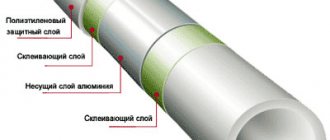Narrowing the diameter of the heating pipe consequences
The right choice: calculating the diameter of the pipe for heating
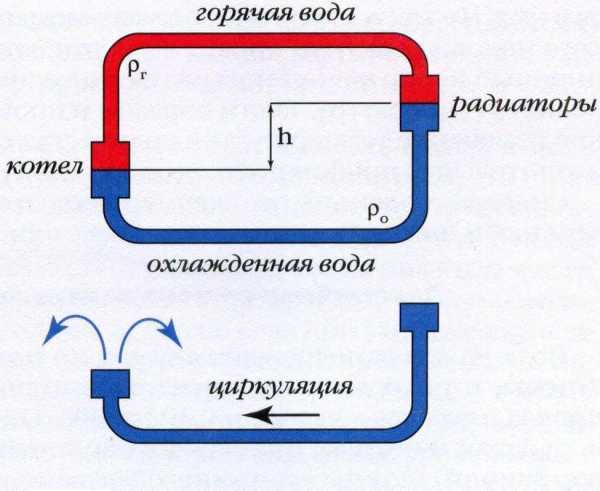
Before installing heating in a house, you must first correctly calculate the diameter of the pipes. The calculation will be considered on systems with forced ventilation. In such systems, the movement of the coolant is provided by a constantly running circulation pump. When choosing the diameter of the pipes, it is taken into account that their main task is to ensure the delivery of the required amount of heat to the heating devices.
Data: how to calculate the diameter of a pipe for heating
To calculate the diameter of the pipeline, you will need the following data: this is the total heat loss of the dwelling, and the length of the pipeline, and the calculation of the power of the radiators of each room, as well as the wiring method. The divider can be one-pipe, two-pipe, forced or natural ventilation.
Also pay attention to the markings on the outer diameter copper and polypropylene pipes. The internal one can be calculated by subtracting the wall thickness. For metal-plastic and steel pipes, the inner dimension is affixed when marking.
Unfortunately, it is impossible to calculate the exact cross-section of the pipes. One way or another, you will have to choose from a couple of options. This point is worth explaining: a certain amount of heat must be delivered to the radiators, while achieving uniform heating of the batteries. If we are talking about systems with forced ventilation, then this is done using pipes, a pump and the heat carrier itself. All that is needed is to drive out the required amount of coolant for a certain period of time.
It turns out that it is possible to choose pipes of a smaller diameter, and supply the coolant at a higher speed. You can also make a choice in favor of pipes of a larger cross-section, but reduce the flow rate of the coolant. The first option is preferred.
Selecting the water speed in the heating system
Higher water velocities and smaller pipes are the most common choices. If you increase the diameter of the pipe, then the speed of movement will decrease. But the latter option is not so frequent, reducing the movement is not very beneficial.
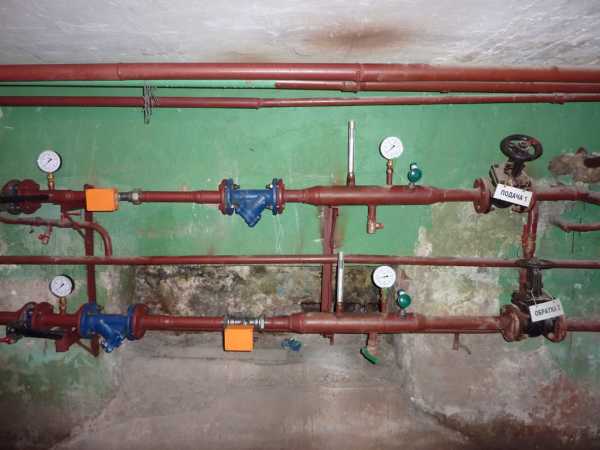

When choosing pipes, you should also take into account the possible speed of water in the heating system.
Why high speed and smaller pipe diameter are more beneficial:
- Products with a smaller diameter cost less;
- It is easier to work with pipes of a smaller diameter at home;
- If the gasket is open, they do not attract attention so much, and if the installation goes into the walls or floor, then smaller strobes will be required;
- The small diameter provides a smaller amount of coolant in the pipe, and this, in turn, reduces the inertia of the system, which saves fuel.
Special tables have been developed by which the size of pipes for the house is determined. Such a table takes into account the required amount of heat, as well as the speed of movement of the coolant, as well as the temperature indicators of the system. It turns out that in order to carry out the selection of pipes of the desired section, the necessary table is found, and the diameter is selected from it. Today, there may be a suitable online program that replaces the table.
Heating system wiring diagram and diameter of pipes for heating
The heating wiring diagram is always taken into account. It can be two-pipe vertical, two-pipe horizontal and one-pipe. The two-pipe system assumes both upper and lower placement of the lines. But the one-pipe system takes into account the economical use of the length of the mains, which is suitable for heating with natural circulation.Then the two-pipe system will require the mandatory inclusion of the pump in the circuit.
There are three types of horizontal routing:
- Dead end;
- Beam or collector;
- With parallel movement of water.
By the way, in the scheme of a one-pipe system, there may also be a so-called bypass pipe. It will become an additional line for fluid circulation if one or more radiators are turned off. Usually, shut-off valves are installed on any radiator, which allow you to shut off the water supply if necessary.
What can be the consequences: narrowing the diameter of the heating pipe
Narrowing the pipe diameter is highly undesirable. When wiring around the house, it is recommended to use the same standard size - you should not increase or decrease it. The only possible exception is the long length of the circulation circuit. But even in this case, you need to be careful.


Many experts do not recommend narrowing the diameter of the pipes, as this can adversely affect the entire heating system.
But why is the size narrowing when replacing a steel pipe with a plastic one? Everything is simple here: with the same inner diameter, the outer diameter of the plastic pipes themselves is larger. This means that the holes in the walls and ceilings will have to be expanded, moreover, seriously - from 25 to 32 mm. But for this you will need a special tool. Therefore, it is easier to pass thinner pipes into these holes.
But in the same situation, it turns out that the tenants who made such a replacement of pipes, automatically "stole" from their neighbors on this riser about 40% of the heat and water passing through the pipes. Therefore, it should be understood that the thickness of the pipes, which is arbitrarily replaced in a thermal system, is not a matter of a private decision, this cannot be done. If steel pipes are replaced with plastic ones, you will have to expand the holes in the ceilings, whatever one may say.
There is also such an option in this situation. It is possible, when replacing risers in old holes, to skip new sections of steel pipes of the same diameter, their length will be 50-60 cm (this depends on such a parameter as the thickness of the overlap). And then they are connected by couplings with plastic pipes. This option is perfectly acceptable.
Calculation of the diameter of a pipe for heating: how to calculate, the speed of water in the system, the consequences of narrowing, the coolant
Calculation of the pipe diameter for heating precedes the calculation of total heat losses, boiler power and radiator power for each room. Also, a wiring method is chosen, a diagram and calculations are drawn up.
Source: teploclass.ru
trubyisantehnika.ru
Calculation of pipe surface area
The tube is a very long cylinder and the surface area of the tube is calculated as the area of the cylinder. For calculations, you will need a radius (internal or external - it depends on which surface you need to calculate) and the length of the segment that you need.


Formula for calculating the lateral surface of the pipe
To find the lateral area of the cylinder, we multiply the radius and the length, the resulting value is multiplied by two, and then by the number "Pi", we get the desired value. If you wish, you can calculate the surface of one meter, then you can multiply it by the desired length.
Related article: Curtains in Italian style - 21 photos in the interior
For example, let's calculate the outer surface of a piece of pipe 5 meters long, with a diameter of 12 cm. First, let's calculate the diameter: we divide the diameter by 2, we get 6 cm. Now all the values must be reduced to the same units of measurement. Since the area is calculated in square meters, we translate centimeters into meters. 6 cm = 0.06 m. Then we substitute everything in the formula: S = 2 * 3.14 * 0.06 * 5 = 1.884 m2. If you round up, you get 1.9 m2.
how to calculate, the speed of water in the system, the consequences of constriction, the coolant
Before installing heating in a house, you must first correctly calculate the diameter of the pipes. The calculation will be considered on systems with forced ventilation.In such systems, the movement of the coolant is provided by a constantly running circulation pump. When choosing the diameter of the pipes, it is taken into account that their main task is to ensure the delivery of the required amount of heat to the heating devices.
Data: how to calculate the diameter of a pipe for heating
To calculate the diameter of the pipeline, you will need the following data: this is the total heat loss of the dwelling, and the length of the pipeline, and the calculation of the power of the radiators of each room, as well as the wiring method. The divider can be one-pipe, two-pipe, forced or natural ventilation.
Also pay attention to the markings on the outer diameter copper and polypropylene pipes. The internal one can be calculated by subtracting the wall thickness. For metal-plastic and steel pipes, the inner dimension is affixed when marking.
Unfortunately, it is impossible to calculate the exact cross-section of the pipes. One way or another, you will have to choose from a couple of options. This point is worth explaining: a certain amount of heat must be delivered to the radiators, while achieving uniform heating of the batteries. If we are talking about systems with forced ventilation, then this is done using pipes, a pump and the heat carrier itself. All that is needed is to drive out the required amount of coolant for a certain period of time.
It turns out that it is possible to choose pipes of a smaller diameter, and supply the coolant at a higher speed. You can also make a choice in favor of pipes of a larger cross-section, but reduce the flow rate of the coolant. The first option is preferred.
Selecting the water speed in the heating system
Higher water velocities and smaller pipes are the most common choices. If you increase the diameter of the pipe, then the speed of movement will decrease. But the latter option is not so frequent, reducing the movement is not very beneficial.


When choosing pipes, you should also take into account the possible speed of water in the heating system.
Why high speed and smaller pipe diameter are more beneficial:
- Products with a smaller diameter cost less;
- It is easier to work with pipes of a smaller diameter at home;
- If the gasket is open, they do not attract attention so much, and if the installation goes into the walls or floor, then smaller strobes will be required;
- The small diameter provides a smaller amount of coolant in the pipe, and this, in turn, reduces the inertia of the system, which saves fuel.
Special tables have been developed by which the size of pipes for the house is determined. Such a table takes into account the required amount of heat, as well as the speed of movement of the coolant, as well as the temperature indicators of the system. It turns out that in order to carry out the selection of pipes of the desired section, the necessary table is found, and the diameter is selected from it. Today, there may be a suitable online program that replaces the table.
Heating system wiring diagram and diameter of pipes for heating
The heating wiring diagram is always taken into account. It can be two-pipe vertical, two-pipe horizontal and one-pipe. The two-pipe system assumes both upper and lower placement of the lines. But the one-pipe system takes into account the economical use of the length of the mains, which is suitable for heating with natural circulation. Then the two-pipe system will require the mandatory inclusion of the pump in the circuit.
There are three types of horizontal routing:
- Dead end;
- Beam or collector;
- With parallel movement of water.
By the way, in the scheme of a one-pipe system, there may also be a so-called bypass pipe. It will become an additional line for fluid circulation if one or more radiators are turned off. Usually, shut-off valves are installed on any radiator, which allow you to shut off the water supply if necessary.
What can be the consequences: narrowing the diameter of the heating pipe
Narrowing the pipe diameter is highly undesirable.When wiring around the house, it is recommended to use the same standard size - you should not increase or decrease it. The only possible exception is the long length of the circulation circuit. But even in this case, you need to be careful.


Many experts do not recommend narrowing the diameter of the pipes, as this can adversely affect the entire heating system.
But why is the size narrowing when replacing a steel pipe with a plastic one? Everything is simple here: with the same inner diameter, the outer diameter of the plastic pipes themselves is larger. This means that the holes in the walls and ceilings will have to be expanded, moreover, seriously - from 25 to 32 mm. But for this you will need a special tool. Therefore, it is easier to pass thinner pipes into these holes.
But in the same situation, it turns out that the tenants who made such a replacement of pipes, automatically "stole" from their neighbors on this riser about 40% of the heat and water passing through the pipes. Therefore, it should be understood that the thickness of the pipes, which is arbitrarily replaced in a thermal system, is not a matter of a private decision, this cannot be done. If steel pipes are replaced with plastic ones, you will have to expand the holes in the ceilings, whatever one may say.
There is also such an option in this situation. It is possible, when replacing risers in old holes, to skip new sections of steel pipes of the same diameter, their length will be 50-60 cm (this depends on such a parameter as the thickness of the overlap). And then they are connected by couplings with plastic pipes. This option is perfectly acceptable.
Correct calculation of the pipe diameter for heating (video)
If you are incompetent in calculating the diameter of pipes, return lines, schemes and the choice of a coolant, it is better to call specialists and ask them to comment on their work.
Happy projects!
Add a comment
teploclass.ru
Weight calculation
With the calculation of the weight of the pipe, everything is simple: you need to know how much a running meter weighs, then multiply this value by the length in meters. The weight of round steel pipes is in reference books, since this type of rolled metal is standardized. The mass of one running meter depends on the diameter and wall thickness. One point: the standard weight is given for steel with a density of 7.85 g / cm2 - this is the type recommended by GOST.


Round steel pipe weight table
In table D - outer diameter, nominal bore - inner diameter, And one more important point: the mass of ordinary steel products is indicated, galvanized 3% heavier.
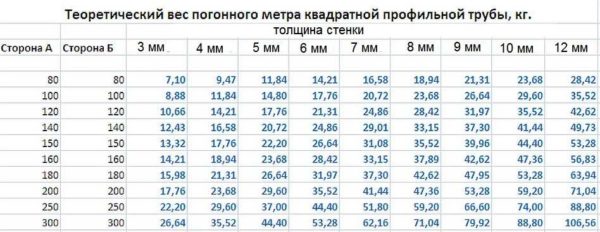

Weight table of profiled square pipe
which one to choose, the consequences of narrowing to the apartment, selection according to the table


Heating a house or apartment is not such a simple engineering system as it might seem at first glance. When drawing up a project, it is required make a lot of calculations, in particular, the required pipeline diameter.
Choosing the right diameter is a guarantee of a reliable, comfortable and efficient system heating of premises.
For example, heating without a pump, where the coolant circulates by gravity, may not work at all with too narrow pipes, and a scheme with forced circulation when the diameter is too low will make noise or not warm up the premises to the desired temperature. Therefore, you should use the calculation rules that will allow you to reduce heat loss to a minimum.
Odnoklassniki
Effect of pipe diameter on efficiency for a heating system in a private house
It is a mistake to rely on the "bigger is better" principle when choosing a pipeline cross-section. Too large pipe cross-section leads to lower pressure in it, and hence the speed of the coolant and heat flow.
Moreover, if the diameter is too large, the pump simply may not have enough performance to move such a large volume of coolant.
Important! A larger volume of the coolant in the system implies a high total heat capacity, which means that more time and energy will be spent on heating it, which also affects the efficiency not for the better.
Selection of pipe cross-section: table
The optimal pipe cross-section should be as small as possible for a given configuration (see table) for the following reasons:
- a small volume of coolant heats up faster;
- less clearance creates more resistance
ogon.guru
One pipe system
Before determining the diameter of the heating pipe, consider two types of single-pipe circuits:
- gravity;
- with forced circulation.
The difference lies in the fact that in an open system, the coolant circulates by gravity, and in a sealed system with the help of pumps. Expansion tanks and their location also differ.
In order for the water in the open circuit to circulate, the conditional passage must be large. So much so that the system is striking. This type of contour is applicable only in private houses, moreover, as it is possible to install only sealed systems in apartments.
The diameter of the pipes for a closed-type one-pipe heating system may differ in different parts of it so that the circuit is balanced.
For small housing, pipes with the same nominal bore are used. In principle, in order to determine what pipe diameter is needed for heating with natural circulation, you can use the formula already known to us.
It should be borne in mind that polypropylene products less than 32 mm are not used, even for small rooms.
Calculation of the diameter of the pipe for heating - a crucial step - Plumber's Tutorial
At a time when it comes to installing a heating system, it is often easy to choose a pipe based on the advice of the usual or the recommendations of the sellers in the store. Calculation of the diameter of a pipe for heating is not always performed.
Choosing a standard size at random, there is a risk that the heating system will work ineffectively.
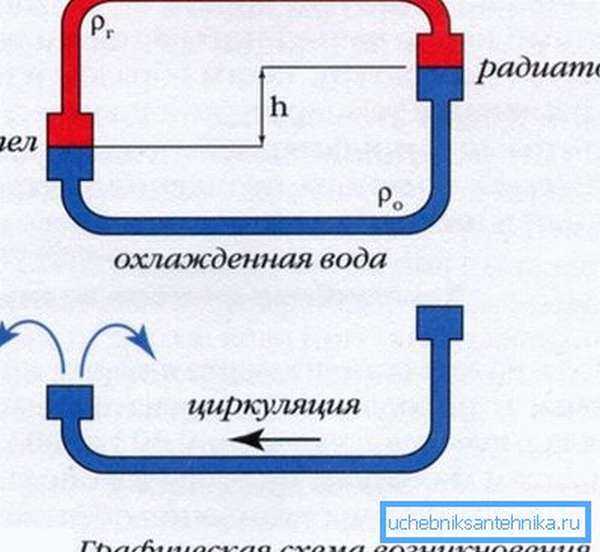

Influence of diameter on heating operation
The installation instructions for the heating system hardly touch upon the issues of calculating the pipeline (in addition, determine how to calculate the diameter of the pipe for heating).
At the same time, when moving through the pipe, the coolant encounters several types of resistances and this must be taken into account when selecting a standard size:
- rubbing against walls... Due to this, some of the speed is lost,
- loss of speed when cornering... It is unrealistic to do the wiring around the apartment without turns (besides, there are turns at an angle of 90?),
- change in diameters... If, when wiring around an apartment, try to use different standard sizes, then resistance to flow movement will also be observed at the interface of various standard sizes.
Note! Narrowing the diameter of the heating pipe is undesirable. When wiring around the house, you must use the same size. An exception is allowed when the length of the circulation circuit is enormous; under such conditions, it is possible to expand the speed of movement of the coolant by reducing D.
As for the pipeline itself, its main feature affecting the movement of the coolant can be called the inner diameter (Dvn). The smaller it is, the greater the pressure, and vice versa - with an increase in DP, the pressure in the system decreases. This must be taken into account at the time when the selection of the diameter of the pipe for heating is carried out.
A common mistake of amateur plumbers is connected with this phenomenon. They are sure that if you take a larger size, then a room will pass through the radiators and a larger amount of coolant will warm up faster.
In fact, the effect will be the opposite - due to the drop in pressure, the batteries will remain cool. Under such conditions, the installation of a more wonderful circulation pump can help out, but the price for a solution is high, it is much easier to choose the right diameter correctly.


Heating system calculation example
In most cases, a simplified calculation is performed based on such parameters as the amount of the room, the level of its insulation, the difference in temperature flow and the speed of the coolant in the supply and discharge pipelines.
The diameter of the pipe for heating with forced circulation is determined in the following sequence:
- the total amount of heat that needs to be supplied to the room is determined (thermal power, kW), it is possible to be guided by the tabular data,


- setting the speed of water movement, determine the optimal D.
Calculation of heat output
An example will be a standard room with dimensions of 4.8x5.0x3.0 m. Heating circuit with forced circulation, you need to calculate the diameters of heating pipes for wiring around the apartment. The main calculation formula looks like this:
the formula uses the following designations:
- V is the number of rooms. In the example, it is equal to 3.8 * 4.0 * 3.0 = 45.6m3,
- ? t is the difference between outdoor and indoor temperatures. In the example, 53 ° C is taken,
- K is a special coefficient that determines the degree of insulation of the building. In general, its value ranges from 0.6-0.9 (effective thermal insulation is used, the roof and floor are insulated, at least double-glazed windows are installed) to 3-4 (buildings without thermal insulation, for example, change houses). In the example, an intermediate option is used - the apartment has standard thermal insulation (K = 1.0 - 1.9), K = 1.1 is taken.
Total thermal power should be equal to 45.6 • 53 • 1.1 / 860 = 3.09 kW.
It is possible to use tabular data.


Determination of the diameter
The diameter of the heating pipes is determined by the formula
Where the notation is used:
- ? t - the difference between the temperatures of the coolant in the supply and outlet pipelines... Considering that water is supplied at a temperature of about 90-95? C, and it has time to cool down to 65-70? C, the temperature difference can be taken equal to 20? C,
- v is the speed of movement of water... It is undesirable for it to exceed the value of 1.5 m / s, and the minimum permissible threshold is 0.25 m / s. It is recommended to stop at an intermediate speed of 0.8 - 1.3 m / s.
Note! The wrong choice of the diameter of the pipe for heating can lead to a drop in speed below the minimum threshold, which, in turn, will lead to the formation of air jams. As a result, the work efficiency will become zero.
The value of Dвн in the example will be v354 • (0.86 • 3.09 / 20) / 1.3 = 36.18 mm. If you pay attention to the standard sizes, for example, the PP pipeline, you can see that there is no Dvn. Under such conditions, the closest diameter of the propylene pipes for heating is easily selected.
In this example, it is possible to select PN25 with a double diameter of 33.2 mm, this will lead to a small increase in the speed of movement of the coolant, but it will still remain within acceptable limits.
Features of heating systems with natural circulation
Their main difference is that they do not use a circulation pump for pressure. The liquid moves by gravity, at the end of heating it is forced upward, after that it passes through the radiators, cools down and returns to the boiler.


Compared to systems with forced circulation, the diameter of pipes for natural circulation heating must be larger. The basis for the calculation in this case is that the circulating pressure exceeds the loss for local resistance and friction.


In order not to calculate the value of the circulating pressure any time, there are special tables compiled for various temperature differences. For example, if the length of the pipeline from the boiler to the radiator is 4.0 m, and the temperature difference is 20 ° C (70 ° C in the outlet and 90 ° C in the supply), then the circulation pressure will be 488 Pa. Based on this, the speed of the coolant is selected using the transformation method D.
When performing calculations with your own hands, a verification calculation is also necessary. In other words, the calculations are carried out in the reverse order, the purpose of the check is to establish whether the losses in local resistance and friction do not exceed the circulating pressure.
Summarizing
The calculation of the heating pipeline is a very important task at the design stage.The information in the article will allow you to independently calculate the heating system, so that a comfortable microclimate in the house is guaranteed (see also the article ‘Which particular pipes for heating are better: analysis of the 4 most common options’).
In the video in this article, the calculation of the pipeline is carried out at the permissible speed.
Loading…
partner-tomsk.ru
Summarizing
Calculation of the heating pipeline is a very important task at the design stage. The information in the article will allow you to independently calculate the heating system, so that a comfortable microclimate in the house is guaranteed (see also the article "Which pipes for heating are better: analysis of the 4 most common options").
In the video in this article, the calculation of the pipeline is carried out at the permissible speed.
Did you like the article? Subscribe to our channel Yandex.Zen
Selection of the diameter of heating pipes - Teplopraktik
The diameter of the heating pipes depends on how much of the coolant will pass through them. Obviously, the diameter will be larger on the main supply pipe from the heating boiler, on a branch with three radiators it will be even smaller, and on the final radiator it will be the smallest. Accordingly, the diameter of the pipe will depend on the total heat output of the radiators that feed this pipeline.
In addition, the diameter of the pipeline depends on the speed of movement of the coolant in the system and on the supply / return temperature difference. The higher this difference, the smaller the required pipe diameter. The standard temperature difference is 20 ° C. In more comfortable systems, this difference is less - 10 ° С.
A heating system with a circulation pump is characterized by a high speed of the coolant, while a system with natural circulation has a low speed, so this must be taken into account when selecting heating pipes. It is not necessary to include in the calculation of pipelines too high speed of water movement in the pipes, because this will create various unpleasant noises and murmurs in the pipes. If the speed is too low, there is a risk of air congestion in the system. The speed of movement in the pipes should be in the range of 0.4 - 0.6 m / s. The gravity system is characterized by a significantly lower speed of the coolant, therefore, the diameter of the pipes must be chosen larger.
Therefore, below we will indicate tables for the selection of pipe diameters for various systems with the specified parameters. The table uses the selection of the diameter of pipes from various materials. Steel pipes VGP are designated by the inner diameter, while polypropylene, metal-plastic and cross-linked polyethylene pipes are designated by the outer diameter. This is taken into account in the table for the selection of pipe diameters.
Supply / return temperature difference - 20 ° С, water speed 0.5 m / s - STANDARD HEATING SYSTEM | ||||
| Heat load, kW | Required inner pipe diameter, mm | Selection of a pipe for the required inner diameter: | ||
| VGP steel | Polypropylene | XLPE | ||
| 50 | 39 | 1.5 inches (40mm) | 50 | 50 |
| 40 | 35 | 1.5 inches (40mm) | 50 | 50 |
| 30 | 30 | 1.25 inches (32mm), quarter inch) | 40 | 40 |
| 20 | 25 | 1 inch (25mm) | 32 | 32 |
| 15 | 21 | 1 inch (25mm) | 32 | 32 |
| 12 | 19 | 3/4 inch (20mm) | 25 | 25 |
| 10 | 17 | 3/4 inch (20mm) | 25 | 25 |
| 8 | 16 | 3/4 inch (20mm) | 25 | 25 |
| 6 | 14 | 1/2 inch (15mm) | 20 | 20 |
| 5 | 12 | 1/2 inch (15mm) | 20 | 20 |
| 4 | 11 | 1/2 inch (15mm) | 20 | 20 |
| 3 | 10 | 3/8 '' (10mm) | 16 | 16 |
| 2 | 8 | 3/8 '' (10mm) | 16 | 16 |
| 1 | 6 | 3/8 '' (10mm) | 16 | 16 |
Supply / return temperature difference - 10 ° С, water speed 0.5 m / s - LOW TEMPERATURE HEATING SYSTEM | ||||
| Heat load, kW | Required inner pipe diameter, mm | Selection of pipe for the required inner diameter: | ||
| VGP steel | Polypropylene | XLPE | ||
| 50 | 55 | 2 inches (50mm) | 63 | 63 |
| 40 | 48 | 2 inches (50mm) | 63 | 63 |
| 30 | 43 | 2 inches (50mm) or 1.5 inches (40mm) | 63 | 63 |
| 20 | 35 | 1.5 inches (40mm) | 50 | 50 |
| 15 | 30 | 1.25 inches (32mm) | 40 | 40 |
| 12 | 27 | 1.25 inches (32mm) | 40 | 40 |
| 10 | 25 | 1 inch (25mm) | 32 | 32 |
| 8 | 22 | 1 inch (25mm) | 32 | 32 |
| 6 | 19 | 3/4 inch (20mm) | 25 | 25 |
| 5 | 17 | 3/4 inch (20mm) | 25 | 25 |
| 4 | 16 | 1/2 inch (15mm) | 20 | 20 |
| 3 | 13 | 1/2 inch (15mm) | 20 | 20 |
| 2 | 11 | 1/2 inch (15mm) | 16 | 16 |
| 1 | 8 | 1/2 inch (15mm) | 16 | 16 |
Supply / return temperature difference - 20 ° С, water speed 0.2 m / s - SELF-DRAIN HEATING SYSTEM | ||||
| Heat load, kW | Required inner pipe diameter, mm | Selection of pipe for the required inner diameter: | ||
| VGP steel | Polypropylene | XLPE | ||
| 30 | 48 | 2 inches (50mm) | 63 | 63 |
| 20 | 39 | 1.5 inches (40mm) | 50 | 50 |
| 15 | 34 | 1.5 inches (40mm) | 50 | 50 |
| 12 | 30 | 1.25 inches (32mm), (quarter inch) | 40 | 40 |
| 10 | 28 | 1.25 inches (32mm), (quarter inch) | 40 | 40 |
| 8 | 25 | 1 inch (25mm) | 32 | 32 |
| 6 | 21 | 3/4 inch (20mm) | 25 | 25 |
| 5 | 19 | 3/4 inch (20mm) | 25 | 25 |
| 4 | 17 | 3/4 inch (20mm) | 25 | 25 |
| 3 | 15 | 3/4 inch (20mm)) | 25 | 25 |
| 2 | 12 | 1/2 inch (15mm) | 20 | 20 |
| 1 | 10 | 1/2 inch (15mm) | 20 | 20 |
Application example: two-pipe system with circulation pump, total power 18 kW.
The wiring is made with a polypropylene pipe, the symbol is PP.
As you can see from the diagram, first a polypropylene pipe with a diameter of 40mm comes out of the boiler, its internal clearance is 25mm, which corresponds to a metal VGP pipe of 1 inch (25mm). Then there is an outlet to the boiler (4 kW) and underfloor heating (2 kW) of two PP pipes with a diameter of 16 mm. After that, part of the coolant separated, so there is no need for such a thick pipe. A thinner pipe - 32mm will already go for heating the 1st and 2nd floors, it will go to the first tee. On the tee, a branch is separated to the 1st floor, with a diameter of 25mm, and to the 2nd floor, also with a diameter of 25mm. A polypropylene pipe with a diameter of 16 mm is already suitable for the final radiators. And on the last 3 radiators, the supply pipe is also narrowed to 16mm.
In a one-pipe system, in contrast to a two-pipe system, the entire coolant of the system is supplied through one pipeline. Therefore, in such a system, the entire pipeline (after branching the pipe to the boiler and underfloor heating) will be 32mm in diameter, and 16mm pipes will be suitable for separate radiators from the main pipeline.
teplopraktik.ru
Two-pipe circuit in a private house
First, let's generalize a little. Take, for example, the calculation of the diameter of polypropylene pipes for heating in a private house. Basically, products with a cross section of 25 mm are used for the circuit, and the taps to the radiators are set at 20 mm.
Due to the fact that the size of the pipes for heating in a private house used as pipes to the batteries is smaller, the following processes take place:
- the speed of the coolant is increasing;
- circulation in the radiator improves;
- the battery warms up evenly, which is important when connecting to the bottom.
Combinations of the main contour diameter of 20 mm and the elbows of 16 mm are also possible.
To make sure of the above data, you can calculate the diameter of pipes for heating a private house yourself. This will require the following values:
- the square of the room.
Knowing the number of heated square meters, we can calculate the power of the boiler and what pipe diameter to choose for heating. The more powerful the heater, the larger the cross-section of the product can be used in tandem with it.
To heat one square meter of the room, 0.1 kW of boiler power is required. The data is valid if the ceilings are standard 2.5 m;
- heat loss.
The indicator depends on the region and wall insulation. The bottom line is that the more heat loss, the more powerful the heater should be. To get around complex calculations that are inappropriate in an approximate calculation, you just need to add 20% to the boiler power calculated above;
- the speed of the water in the circuit.
The coolant speed is allowed in the range from 0.2 to 1.5 m / s. Moreover, in most calculations of the diameter of pipes for heating with forced circulation, it is customary to take an average value of 0.6 m / s.
At this speed, the appearance of noise from friction of the coolant against the walls is excluded;
- how much the coolant cools.
For this, the return temperature is subtracted from the flow temperature. Naturally, you cannot know the exact data, especially since you are at the design stage.
Therefore, operate on average data, which are 80 and 60 degrees, respectively. Based on this, the heat loss is 20 degrees.
Now the calculation itself is how to choose the diameter of the pipe for heating. To do this, take a formula in which there are initially two constants, the sum of which is 304.44.
Conditional passage of the circuit, squared = 304.44 x (square of the room x 0.1 kW + 20%) / heat loss of the coolant / flow rate.
The last step is to extract the square root of the result. For clarity, we will calculate what pipe diameter to use for heating a private house with one floor with an area of 120 m2:
304.44 x (120 x 0.1 + 20%) / 20 / 0.6 = 368.328
Now let's calculate the square root of 368.328, which is 19.11 mm. Before choosing the diameter of the pipe for heating, once again we emphasize that this is the so-called conditional passage.
Products made of different materials have different wall thicknesses. For example, polypropylene has thicker walls than metal-plastic. Since we have dried a polypropylene loop as a sample, we will continue to consider this material.
The marking of these products indicates the outer section and wall thickness. Using the subtraction method, we find out the value we need and select it in the store.
For convenience, we will use the table.
Based on the results of the table, we can conclude:
- if a nominal pressure of 10 atmospheres is sufficient, then an outer section of a pipe for heating of 25 mm is suitable;
- if a nominal pressure of 20 or 25 atmospheres is required, then 32 mm.
How to calculate cross-sectional area
Formula for finding the cross-sectional area of a round pipe
If the pipe is round, the cross-sectional area must be calculated using the formula for the area of a circle: S = π * R2. Where R is the radius (inner), π - 3.14. In total, you need to square the radius and multiply it by 3.14.
For example, the cross-sectional area of a pipe with a diameter of 90 mm. Find the radius - 90 mm / 2 = 45 mm. In centimeters, this is 4.5 cm. We square it: 4.5 * 4.5 = 2.025 cm2, we substitute in the formula S = 2 * 20.25 cm2 = 40.5 cm2.
The cross-sectional area of a profiled pipe is calculated using the formula for the area of a rectangle: S = a * b, where a and b are the lengths of the sides of the rectangle. If we consider the section of the profile 40 x 50 mm, we get S = 40 mm * 50 mm = 2000 mm2 or 20 cm2 or 0.002 m2.
Related article: How to remove fungus from walls in an apartment with folk remedies
Inner and outer diameter, wall thickness, radius
Pipes are a specific product. They have an inner and outer diameter, since their wall is thick, its thickness depends on the type of pipe and the material from which it is made. In the technical specifications, the outer diameter and wall thickness are often indicated.
If, on the contrary, there is an inner diameter and wall thickness, but an outer one is needed, we add double the thickness of the stack to the existing value.
With radii (denoted by the letter R) it is even simpler - this is half of the diameter: R = 1/2 D. For example, we find the radius of a pipe with a diameter of 32 mm. Just divide 32 by two, we get 16 mm.
What if there is no technical data for the pipe? To measure. If you do not need special accuracy, a regular ruler will do, for more accurate measurements it is better to use a vernier caliper.









